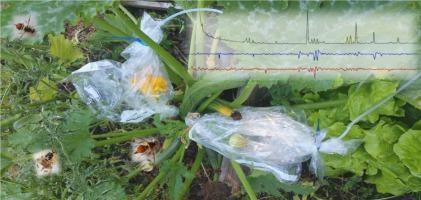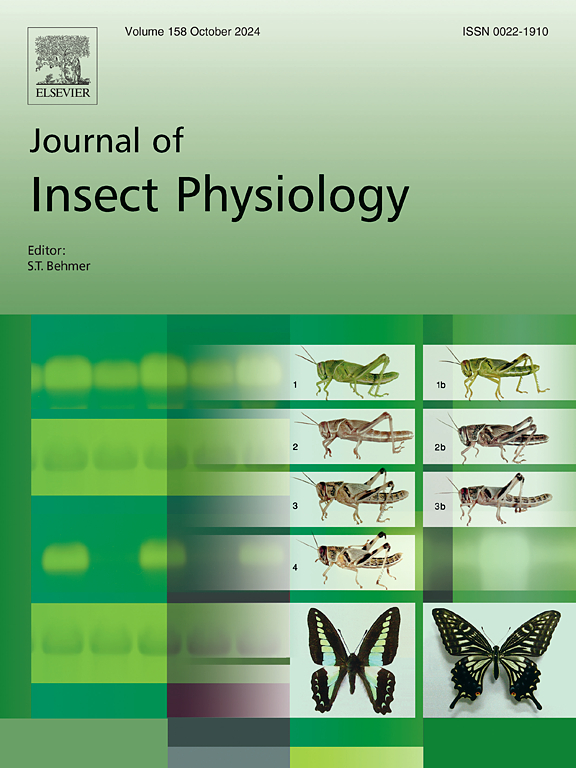Comparison of electrophysiological and behavioral responses of tephritid (Diptera: Tephritidae) pests to cucurbit host odors
IF 2.3
2区 农林科学
Q1 ENTOMOLOGY
引用次数: 0
Abstract
Developing species-specific lures for female tephritid fruit flies is crucial for sustainable pest management, yet remains a significant challenge. This study aimed to identify potential attractants for Zeugodacus cucurbitae, a major pest on cucurbit crops, by comparing the olfactory responses of females to host plant volatiles with those of two related fruit-infesting species, Bactrocera dorsalis and Ceratitis capitata. Using gas chromatography coupled electroantennogram detection (GC-EAD) and GC-mass spectrometry (GC–MS), we identified 28 antenna-active compounds from flowers and fruits of Cucumis sativus L., Cucurbita pepo L., and Cucurbita mixta L. While eight compounds elicited responses in all three tephritid species, indicating shared olfactory sensitivity, B. dorsalis and C. capitata detected a broader range of volatiles than Z. cucurbitae. Behavioral assays in a six-choice olfactometer demonstrated that synthetic blends based on cucurbit host odors attracted females of all three species. These findings suggest that, while there is some overlap in host odor perception, subtle differences exist that could be exploited for species-specific lure development. Further optimization and field testing of these promising blends are recommended to enhance targeted pest management strategies for Z. cucurbitae.

蛾类(双翅目:蛾科)害虫对瓜类寄主气味的电生理和行为反应比较
为雌性伤寒果蝇开发特定种类的诱饵是可持续害虫管理的关键,但仍然是一个重大挑战。摘要本研究通过比较瓜类作物中主要害虫——桔小实蝇(Bactrocera dorsalis)和头角角蝇(Ceratitis capitata)雌性对寄主植物挥发物的嗅觉反应,以确定瓜类作物中潜在的引诱物。采用气相色谱耦合天线电图检测(GC-EAD)和气相色谱质谱分析(GC-MS)技术,从黄瓜(sativus L.)、葫芦(Cucurbita pepo L.)和混合葫芦(Cucurbita mixta L.)的花和果实中鉴定出28种天线活性化合物,其中8种化合物在3种昆虫中均能引起反应,表明它们具有相同的嗅觉敏感性,dorsalis和C. capitata对挥发物的检测范围比葫芦(Z.葫芦)更广。在六种选择的嗅觉仪中进行的行为分析表明,基于葫芦宿主气味的合成混合物吸引了所有三种雌性。这些发现表明,虽然寄主的气味感知有一些重叠,但存在细微的差异,可以用于物种特异性诱饵的开发。建议进一步优化和田间试验这些有前途的杂交品种,以加强葫芦小蠊的针对性防治策略。
本文章由计算机程序翻译,如有差异,请以英文原文为准。
求助全文
约1分钟内获得全文
求助全文
来源期刊

Journal of insect physiology
生物-昆虫学
CiteScore
4.50
自引率
4.50%
发文量
77
审稿时长
57 days
期刊介绍:
All aspects of insect physiology are published in this journal which will also accept papers on the physiology of other arthropods, if the referees consider the work to be of general interest. The coverage includes endocrinology (in relation to moulting, reproduction and metabolism), pheromones, neurobiology (cellular, integrative and developmental), physiological pharmacology, nutrition (food selection, digestion and absorption), homeostasis, excretion, reproduction and behaviour. Papers covering functional genomics and molecular approaches to physiological problems will also be included. Communications on structure and applied entomology can be published if the subject matter has an explicit bearing on the physiology of arthropods. Review articles and novel method papers are also welcomed.
 求助内容:
求助内容: 应助结果提醒方式:
应助结果提醒方式:


